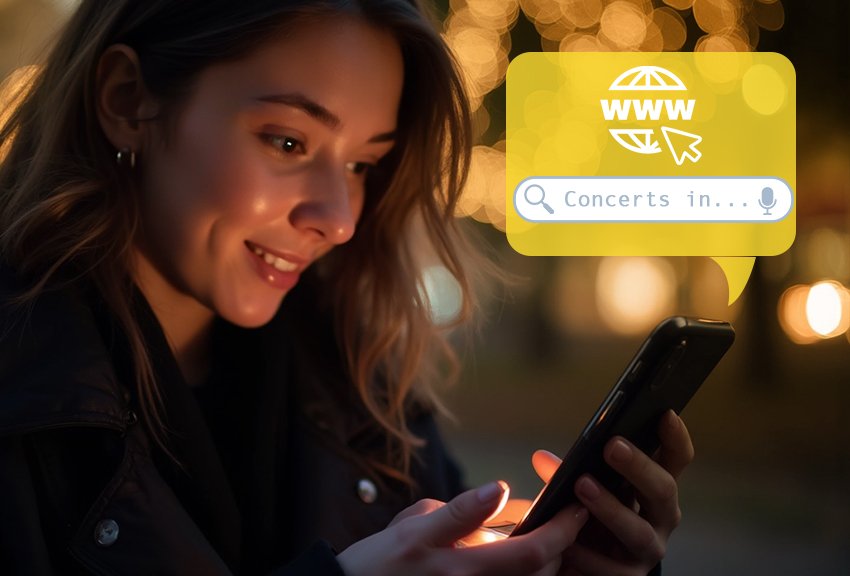When it comes to organizing concerts or live events, the focus is often solely on selling out tickets. But if you’re only tracking ticket sales, you’re missing out on crucial data that could transform your event’s profitability. By diving deeper into metrics like Cost Per Acquisition (CPA), Engagement Rates, Return on Ad Spend (ROAS), and Customer Lifetime Value (CLV), you can fine-tune your strategies, increase your event’s return on investment (ROI), and build long-term success. Let’s explore how to make every marketing dollar count and boost your event’s success.
1. Measure Cost Per Acquisition (CPA) for Maximum Profitability
What is CPA?
Cost Per Acquisition (CPA) is a metric that shows how much it costs to acquire one ticket buyer. It includes all your marketing expenses, from social media ads to email campaigns, divided by the number of tickets sold. For example, if you spend $2,000 on advertising and sell 100 tickets, your CPA is $20 per ticket.
Why CPA Matters
- Lower CPA = Higher Profits: If your ticket price is $30 but your CPA (Cost Per Acquisition) is $25, that means you’re only making a $5 profit per ticket sold. Lowering your CPA allows you to keep more of the revenue, which directly improves your event’s profitability. For example, by optimizing your ad targeting and reducing unnecessary spend, you could bring your CPA down to $15. Now, you’re making a $15 profit per ticket, which can significantly boost your overall earnings, especially for large events with hundreds or thousands of attendees.
- Efficient Budget Allocation: Knowing your CPA helps you understand which marketing channels deliver the best bang for your buck. For instance, if your Facebook ads have a CPA of $10 while your Google ads have a CPA of $20, it’s clear that Facebook is the more cost-effective option. This insight ensures that you allocate your budget to the most profitable channels, avoiding wasteful spending. By regularly monitoring your CPA, you can shift resources quickly, focusing on channels that are performing well and pausing or tweaking those that aren’t.
How to Optimize CPA
- Use Retargeting Ads: Retargeting involves showing ads to users who have already visited your event page or engaged with your social media content. These are warm leads, which means they are more likely to buy tickets. Retargeting typically has a lower CPA because it focuses on users already interested in your event.
Example: Let’s say a user clicks on your Facebook ad but doesn’t buy a ticket. A retargeting ad that shows up later on Instagram, featuring a limited-time discount, could be the nudge they need to purchase. - Refine Audience Targeting: Avoid wasting your budget on broad, generic ads. Instead, narrow your audience to specific demographics, such as age groups, interests, or location. The more targeted your approach, the lower your CPA.
Tip: Use Facebook’s Lookalike Audiences to reach people similar to your existing customers. This method can reduce your CPA by focusing on users who are already inclined to buy.
2. Track Engagement Rates to Understand Audience Interest
What Are Engagement Rates?
Engagement rates measure how your audience interacts with your content, including likes, shares, comments, and clicks. For concerts, a high engagement rate indicates that fans are excited and more likely to purchase tickets.
Why Engagement Rates Matter
- Boosts Brand Awareness: Engagement rates play a key role in increasing visibility for your event. The more people interact with your posts, the more they appear in others’ feeds, especially on platforms like Instagram and Facebook, which prioritize content with high engagement. This visibility is essential for concerts, where generating excitement and hype early on can lead to a rush of ticket sales. For example, if a video post about your concert garners high engagement, it may appear in trending sections, attracting even more attention.
- Identifies Effective Content: Analyzing which posts generate the most engagement allows you to focus on creating similar content that resonates with your audience. For instance, if fans are responding enthusiastically to behind-the-scenes footage of artists or sneak peeks of the setlist, you can prioritize more of that content. By tracking engagement rates, you’ll gain insights into what your audience truly enjoys, allowing you to fine-tune your marketing strategy. This approach ensures that every post, story, or tweet serves a purpose in driving interest and, ultimately, ticket sales.
How to Optimize Engagement Rates
- Leverage Interactive Content: Use polls, quizzes, or Instagram Stories to engage fans. For example, you could create a poll asking fans to vote on the setlist or a quiz about the performing artist. Interactive content encourages users to participate, keeping your event top-of-mind.Example: An Instagram poll asking fans to choose the opening song can drive engagement and create a sense of involvement, increasing the likelihood they’ll attend the concert.
- A/B Test Your Content: Try different formats—like videos, carousel posts, or infographics—to see which ones get the best response. If your audience engages more with videos, focus your efforts on creating compelling video content to boost engagement.
Tip: Use tools like Hootsuite or Buffer to schedule posts at times when your audience is most active to maximize engagement.
Want to boost your social media engagement even further? Check out our tips on how to Boost Your Event’s Visibility!

Maximizing ROI isn’t just about ticket sales— it’s about optimizing every touchpoint to create a lasting impact.
3. Optimize Return on Ad Spend (ROAS) for Higher Returns
What is ROAS?
Return on Ad Spend (ROAS) measures the revenue generated for every dollar spent on advertising. For example, if you spend $1,000 on ads and earn $5,000 in ticket sales, your ROAS is 5x. This metric helps you understand which ads are delivering the best returns.
Why ROAS Matters
- Direct Indicator of Ad Effectiveness: This metric is a direct indicator of how effective your ads are at converting clicks into sales. A high ROAS means that your advertising strategy is working, while a low ROAS suggests the need for adjustments, like refining your targeting or creative.
- Guides Budget Allocation: Understanding which channels yield the highest ROAS enables you to allocate your budget more efficiently. If you find that Instagram ads are producing a ROAS of 5x while Google ads are only achieving 2x, it’s clear where you should invest more resources. By focusing your spending on platforms with the highest returns, you can optimize your marketing efforts to achieve greater profitability. This not only boosts revenue but also reduces wasteful spending, helping to maximize your event’s bottom line.
How to Optimize ROAS
- Focus on High-Performing Channels: Identify which platforms generate the highest ROAS and allocate more budget there. For instance, if Instagram Stories drive better results than Facebook posts, concentrate your efforts on Stories.
Example: If you see that video ads are performing better than image ads, shift your budget towards more video content to maximize returns. - Implement Conversion Tracking: Use tracking tools like Google Analytics or Facebook Pixel to monitor which ads lead to ticket sales. This data allows you to adjust your campaigns in real-time for maximum efficiency.
Struggling to optimize your ad budget? Learn how to achieve a higher ROAS with our detailed guide on concert ticket pricing and promotion tactics.
4. Monitor Customer Lifetime Value (CLV) for Long-Term Success
What is CLV?
Customer Lifetime Value (CLV) measures the total revenue you can expect from a customer over the duration of their relationship with your brand. For event promoters, CLV includes repeat ticket purchases, merchandise sales, and referrals.
Why CLV Matters
- Maximizes Long-Term Revenue: For concerts and events, it’s not just about filling seats for one show—it’s about creating loyal attendees who will return for future concerts. If you identify customers with a high CLV, you can focus your marketing efforts on them, perhaps by offering loyalty programs or early-bird access to tickets. For instance, sending exclusive offers to fans who have attended multiple events can encourage them to keep coming back.
- Builds a Loyal Community: Understanding CLV helps you develop strategies to nurture long-term relationships with your audience. A high CLV often indicates a loyal fanbase that’s likely to promote your events through word-of-mouth. By cultivating this loyalty—through personalized emails, exclusive content, or special discounts—you turn one-time ticket buyers into repeat attendees. This not only stabilizes your revenue but also builds a community of fans who are excited to support your events year after year.
How to Optimize CLV
- Create Loyalty Programs: Offer discounts or early access to tickets for repeat customers. This rewards loyalty and encourages fans to keep attending your events.
Example: Send exclusive early-bird offers to past attendees, making them feel valued and more likely to purchase tickets for future events. - Segment Your Audience: Use email marketing to segment your high-value customers and send personalized content. For instance, offer VIP packages to fans who have attended multiple concerts in the past.
5. Leverage Post-Event Analytics for Continuous Improvement
What is Post-Event Analytics?
Post-event analytics involves collecting data after the event to assess its success. This can include feedback surveys, social media engagement, and sales reports.
Why Post-Event Analytics Matter
- Improves Future Events: Analyzing post-event data, such as attendee feedback and sales reports, helps you identify what went well and what could be improved for your next concert. For example, if feedback reveals that attendees loved a particular opening act or venue, you can replicate that success in future events. Conversely, if issues like long wait times or unclear signage were common complaints, you can address these to enhance the attendee experience. This continual learning process helps refine your event planning and marketing strategies, leading to better profitability over time.
- Builds Attendee Loyalty: Gathering feedback from surveys, social media comments, and reviews not only helps you improve future events but also shows your audience that you value their opinions. When attendees feel heard, they’re more likely to attend your events again. For example, sending out a post-event survey with a discount code for a future event can encourage repeat attendance while also collecting valuable insights. Understanding what your audience enjoyed (or didn’t) ensures that each concert gets better, keeping fans engaged and eager to return.
How to Optimize Post-Event Analytics
- Send Follow-Up Surveys: Collect feedback to find out what attendees loved and what could be improved. This data helps you tailor future events to meet audience expectations.
Example: Include questions about the concert experience, such as sound quality, seating comfort, or artist performance. Use this feedback to enhance the next event. - Analyze Social Media Sentiment: Track hashtags, mentions, and comments to gauge attendee satisfaction. Positive engagement signals success, while negative feedback highlights areas for improvement.
Master the Metrics to Maximize Your Event’s ROI
Understanding and optimizing metrics beyond ticket sales is key to running a profitable event. By focusing on CPA, Engagement Rates, ROAS, CLV, and post-event analytics, you can ensure every marketing dollar is well-spent.
If you want to read more on strategies to improve your ROI, check out our expert guide on strategies to achieve higher profitability.
Don’t leave your event’s success to chance—partner with experts who understand the concert industry inside and out. Contact us today to create a marketing strategy tailored to your goals. Let’s sell more tickets and make your next event unforgettable!






